Planet of the Apes and The Alligator People (Atari 2600 Reviews)
April 14, 2024 2 Comments
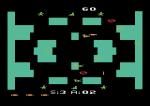 The Alligator People
The Alligator People
Platform: Atari 2600
Unreleased Complete (?) Prototype
Designed by John Russel
Non-Publisher: 20th Century Fox
NEVER BEEN RELEASED
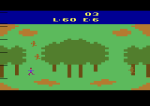 Planet of the Apes
Planet of the Apes
Platform: Atari 2600
Unreleased Nearly Completed Prototype
Designed by John Marvin
Non-Publisher: 20th Century Fox
NEVER BEEN RELEASED
This was originally going to be part of Atari 50: The Games They Couldn’t Include – The Definitive Review Part Three, but I have a lot to say about 20th Century Fox’s Atari output.
I decided to lump these two games together because they’re spiritually married to each other for the most bizarre reason. Based on a low budget sci-fi film from 1959, Alligator People was discovered by a game collector in 2002. Apparently, this came as an incredible shock to the Atari community, because they thought they’d already had found Alligator People years earlier. It turned out, the game that everyone thought was Alligator People was really Planet of the Apes, another nearly completed but unreleased 20th Century Fox game. Having played the two games, I can’t believe anyone could confuse one for the other, but they did have a valid reason: the prototype cartridge that Planet of the Apes was housed in was labeled “Alligator People.” Even though nothing resembling an alligator is in Planet of the Apes, this is the Atari VCS we’re talking about, where everything is a little abstract. I imagine this situation was the gaming equivalent of a Rorschach test. “I see.. alligators? I guess?” The theory is that the designer grabbed the nearest EPROM cart handy, which happened to be a cart that previously housed a build of Alligator People. Who knew the confusion that would eventually cause?
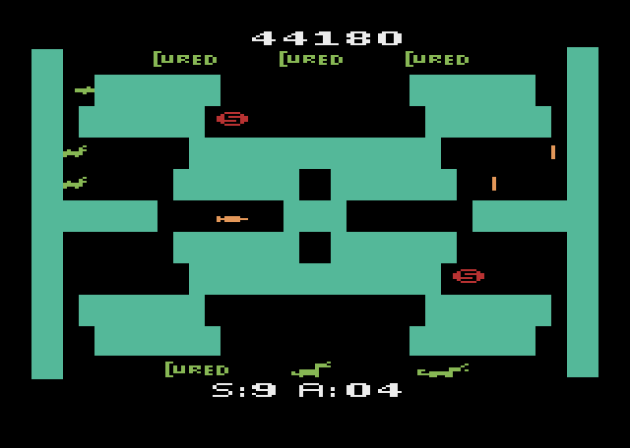
It’s not much to look at, but this is actually a pretty good game. More importantly, the groundwork for a better game is laid here. I’d really like to see someone remake this “collect antidote, avoid moving walls and enemies, then cure people” action game concept. I’m not joking. With more elegant wall movement patterns and better enemies, this could be an all-time great action game. It feels like that potential is there.
Apparently, poor focus test results with children killed Alligator People before it was sent to manufacturing, possibly because it was too easy for them. Huh? If 20th Century Fox was using little kids for focus testing, they made a grave error in judgment. First off, the game isn’t easy. You can turn on infinite lives by toggling the switches, but as the game progresses, it does get a lot harder. I suspect the kids who played it weren’t interested in it because it was based on a movie they’d never heard of. Alligator People is one of the better unreleased 2600 prototypes I’ve played, but I doubt a preteen from that era would like it. It’s an arcade shooter where you have to cure six people who are slowly transforming into alligators. You have to run around and collect S icons which represent “serum” and little dots, which represent the antidote doses. The serum increases the potency of the antidote, though the effect seems subtle. There’s six people that are changing, and you have to shoot them with the antidote until the word CURED appears in their place. As you do this, alligators come out the sides of the screen. When you shoot these alligators, they die. Pretty basic stuff, right?

At the start of stages, where the humans are at the earliest stage of their transformation, you can probably clear an entire side out with minimal bullets and serum upgrades.
The big twist is that the walls move and are capable of crushing you. It doesn’t seem random as there’s a pattern to it, but even after an hour I had trouble predicting when would be a good time to make my moves or not. In later stages, you have to move fast if you lose a life. Otherwise, you will die almost immediately from getting squashed by the walls. The other twist is that, while serum icons constantly spawn, the antidote bullets don’t refresh unless you’ve collected every one of them. Sometimes, you’ll find yourself needing several rounds to cure a person, and might have to wait quite a while before you’re able to grab the last antidote on the screen and get ten more rounds to appear. As frustrating as it is, it actually does make for an intense action game. Wisely, only your shots fired on the six target humans will deplete your antidote stock. You can shoot the alligators that roam the level without draining your inventory. SMART. That’s something you wouldn’t expect from an Atari game, especially in a prototype.
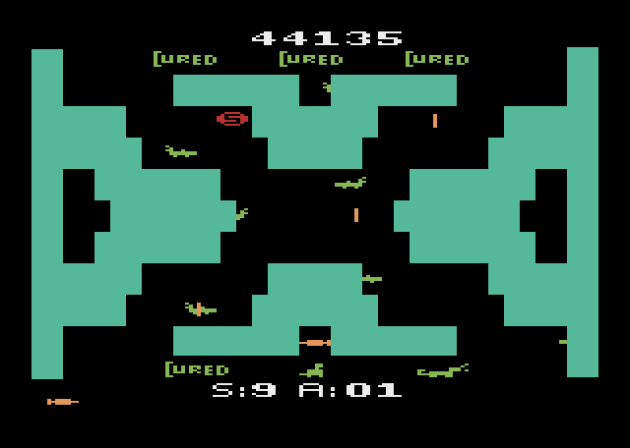
Yep, I’m dead here.
There’s still some roughness that I imagine would still have made it into the final release, as I have no idea how they would be able to polish it out. More than once, I got stuck on the corner of a wall, unable to move despite having a wide open space all around me. It’s also really hard to keep track of where the enemy alligators are. Finally, there’s no fail condition for transforming humans. If they make it all the way to the alligator form, that just means you need more bullets to turn them back. It could have been a spinning plate element, but given the fact that sometimes you have to wait a LONG time for a clearing, both for grabbing the last doses of the antidote and for a clear shot to cure the humans, maybe they were especially wise to not have the humans act as a ticking clock. If you wish, you can partially cure a human, but if left alone, they’ll keep right on with the transformation. Overall, this is a VERY good action game. Maybe not quite up to the level of greatness, but a solid, enjoyable and highly original arcade experience. It sucks that it never came out. It has cult hit written all over it, and to a higher degree of many would-be cult Atari VCS releases that didn’t pan out like Halloween or Journey: Escape.
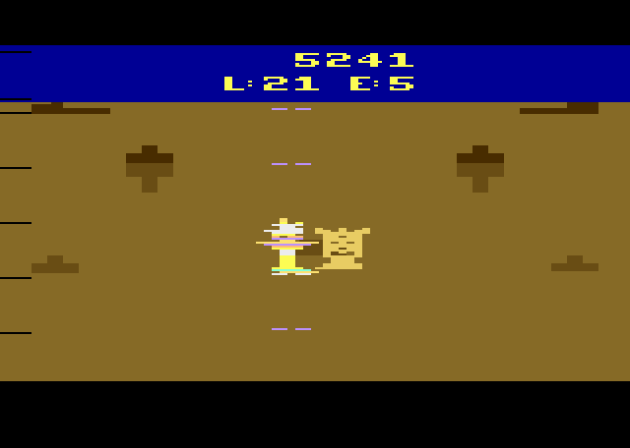
This is supposed to be the famous “DAMN YOU ALL TO HELL” scene from Planet of the Apes. It just doesn’t work, does it?
Planet of the Apes is a completely different beast. It feels sort of like a more action-oriented version of the Lost Woods sequence from the original Legend of Zelda. Or, it would if it was actually hard to find your way around. Playing the role of Charlton Heston, you have to mostly move south while shooting, or avoiding, two of the three types of enemies as you make your way to the Statue of Liberty. And yes, I said two of the three. The smallest of the three can’t capture you, damage you, or impede your progress in any way. Whether or not that was intended to carry-over into the final release, I don’t know. I suspect the enemies weren’t entirely finalized, and I base that hunch on the ridiculous scoring system.
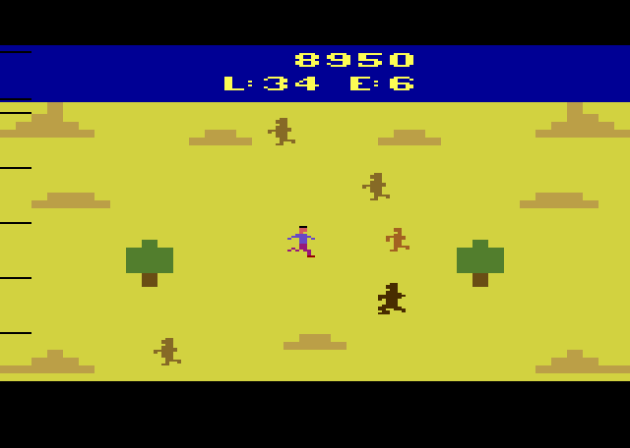
Top to bottom: medium ape, medium ape, small ape, big ape, medium ape. Oh, and me-ape. Apparently they’re supposed to be chimpanzees (small), orangutans (medium) and gorillas (large).
Shooting the smallest ape gives you 3 points. The medium sized ones give 200 points, while the biggest ones, which also shoot at you and drain two of your health points, score only 42 points. Why would the most dangerous apes be worth a little over 20% of the value of the non-projectile-firing medium apes? There’s no way this was intended to be the final scoring system. It’s complete nonsense that eliminates the thrill of high scores from the game because the scoring isn’t based on the challenge. But it gets even worse than that, too. The large apes only shoot up and down, and while in theory that means they make shooting the other enemies more challenging since you have to dodge bullets, that requires the shooters to be on the screen to create the danger element. They often aren’t. Even on higher difficulty settings, the enemies have no attack patterns besides running across the screen in a straight line. It’s too easy to just park in one spot and pick them off as they spawn for easy points. They tend to spawn in the same spots, so not only is the points system broken, but it’s fish in a barrel, or apes as it were. This could have been fixed in so many ways, from limiting YOUR ammo to having your life drain if you stay on any screen too long. Maybe it’s unfinished, or maybe the design is just bad. That’s the rub with reviewing a prototype: you can’t know. In the case of Planet of the Apes, my gut tells me it was never going to get that complex.

L = your life remaining and E = escapes, which is how many times you’re allowed to fall into a pit (there’s pits, though thankfully they’re nothing like those from E.T.) or be caught by the apes but escape from the cage. Unlike Alligator People, Planet of the Apes couldn’t have been released in the state it’s in. Now, how close it was to being ready is up for debate, but there was enough here for me to render a verdict on.
I can only play the version that I have, and because of the poor scoring balance and shoddy action, the game has to stand on its adventure elements, and it can’t. The majority of the game is just about moving from the top of the screen to the bottom. Sometimes you have to walk around trees. Sometimes you have to cross a river. But it’s mostly just walking down. If you get caught by one of the medium/large apes, you get taken to a village where you have to use one of your limited escapes (you just press the action button) to get out of the cage. From there, you have to.. let me check my notes.. oh right, move down several screens. In fact, it’s only when you reach the caves that you have to move in a direction other than down. Your health slowly drains while in the caves, but since you’re passing into the “forbidden zone” from the film, there’s no apes to fight.
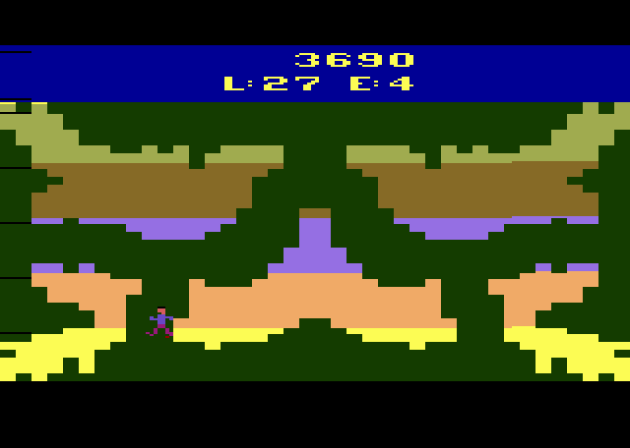
Also your character is tripping balls on acid in the caves. That explains the health depletion. Actually, it’s funny I joked about the Rorschach test because that kind of looks like one, doesn’t it? I see.. a string bikini with love handles and sagging boobs. Oh don’t look at me like that. YOU SEE IT TOO, DAMNIT!
What happens next is supposed to depend on if you ever got caught and sent to the village. If you were never caught, you have to move down a screen, left a screen, and down a screen. If you are caught, it’s down a screen, left a screen, then down two screens. But actually, I found that I usually had to move down, left, and then down twice no matter what. When you reach the Statue of Liberty, the screen flashes dramatically as you realize it was Earth all along, then you start over from the beginning and just repeat the same sequence of navigation. So, it’s not exactly a maze game. It’s completely possible that there were bigger plans, but this prototype is pretty far along and the gameplay is really underwhelming. Unless they added a compass and randomized the pathway to the Statue of Liberty, this never had potential to be a good game. No matter how many laps you do, the path to the ending is the same every time. Lame.
Planet of the Apes was cancelled after designer John Marvin left 20th Century Fox’s game development wing shortly before they exited the market. So, we’ll never really know if this could have been a good game, right? Nah, we know. This was dead on arrival whether or not it was released. It doesn’t do anything right except kind of, sort of mimic the set-pieces from the film. While I still believe that gamers today should have legal access to it, it’s hardly a tragedy that Planet of the Apes was cancelled. But Alligator People not releasing is a crying shame. It’s a fresh take on a tired genre, and that was a rarity in the follow-the-leader world of Atari 2600 games. Now, the real question is who is the genius that thought it would be a good idea to base an early 80s Atari game on an obscure 1959 movie that was a throw-in double feature with Return of the Fly? At least Planet of the Apes is a famous, and timeless, motion picture with set pieces that lend themselves to gaming. But Alligator People? Really? That’s just the tip of the iceberg of 20th Century Fox’s head-scratching Atari lineup. In Atari 50: The Games They Couldn’t Include – The Definitive Review Part Three, I’ll be looking at games based on M*A*S*H*, Fantastic Voyage, and even the teen sex comedy Porky’s. Yes, really.

Fun for all ages.
So, why do these games exist at all?
During the 80s and 90s, media execs tended to believe that video games were lowbrow entertainment that required no talent to produce. It was easy money. Just tell the suit in charge of your media conglomeration’s game division to make a cartridge based on whatever media property springs to mind. The nerds being paid slave wages who work under the suit push a few buttons on a computer, and out pops a multi-million-dollar profit that your board of directors doesn’t understand the appeal in at all, but golly do they sure love the money it makes. I mean, that’s really not far from the truth of what their attitude was. They didn’t comprehend that actual artistry was involved, especially at the start of the home gaming era. It was hogwash to them. A children’s fad made by sloven computer nerds. Not real entertainers like recording artists or film makers. Dweebs sitting at a keyboard writing computer code. Nothing more, and certainly not art. That’d be like saying Scrabble or Monopoly is art, and we know they ain’t, therefore video games aren’t either. But they sure made a lot of money and they were fine with that aspect. That’s why all the big Hollywood players bailed on gaming at the first sign of market trouble. Warner Bros. Fox. Universal. All of them. They didn’t think twice about a possible rebound. They couldn’t have even if they wanted to, because they didn’t have a clue what they had with their game divisions. They never did to begin with.

Never mind the test of time for just a moment. Spare a thought for gamers of the Atari era. For the most part, they were at the mercy of management who just didn’t f’n get it. Who would look at something like this screenshot and, no matter how much money it made for them, roll their eyes and say “whatever.” While it was inevitable quality games would make their way to the market, it also assured an environment where players would be bombarded with low quality games from media companies trying to strike while the iron was hot, a metaphor that only works if you expect that iron to eventually cool. While the business was cynical, the results weren’t always. The company who made the Veg-o-Matic published games under the Xonox label, and those games felt ambitious, like Robin Hood, pictured above. Their games weren’t actually good, but the effort was there.
Think about it. After the Atari 2600 blew up, Warner Bros. had earnings and profits that were almost entirely Atari-based in 1982, but their executives still promised a five-week turnaround on E.T. because they had no clue how much effort a good game requires. Hell, they didn’t even know what a good game was and wouldn’t have been able to tell apart good ones from bad ones, even if they played them. As far as they were concerned, kids were idiots and would buy anything if it had the right branding on it. They even had evidence of that. Warner Bros. had pre-sold between three to four million copies of Pac-Man for the Atari 2600 on name recognition alone, before the first piece of code had been written. The sales proved to them it didn’t matter that the actual game had only a passing resemblance to the arcade hit. This reinforced everything the executives believed. They got the rights to Pac-Man, they told their game people to make a cart of it, and that cart went triple platinum. At that moment, it must have felt like they had a license to print money. That the actual Pac-Man 2600 game was so badly done that it was like unleashing a wrecking ball on Atari’s reputation was beyond their scope of comprehension. It was a cartridge that said Pac-Man and played a video game with ghosts and dots. What more do you people want?
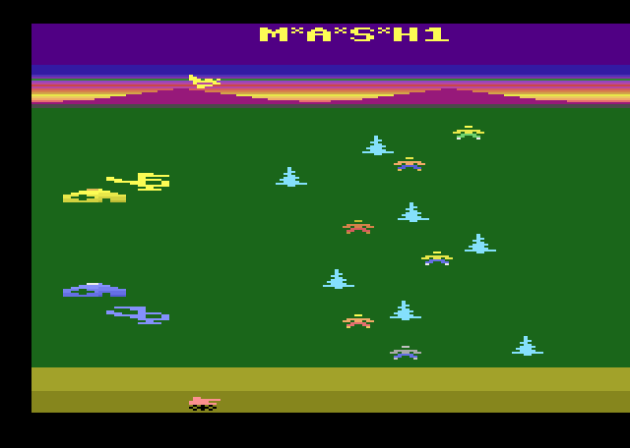
Did kids actually watch M*A*S*H*? The film or the TV show? Doesn’t aiming a game at grown-ups like M*A*S*H* or Porky’s contradict using children in focus testing on games like Alligator People? Did anyone in charge at 20th Century Fox ever pause for one goddamned moment to think about their circular logic?
And mind you, Warner Bros. did better than most, likely on account of having more skin in the game. Atari made the hardware that played the games, while everyone else was riding their coattails. 20th Century Fox had a lot less limitations to work with. I have a hunch that some exec at Fox said “we’re in the game business now!” and went down their film and television catalog identifying what properties they owned that they could sprinkle fairy dust on and turn into one of them newfangled electronic games the kids were raving about. “I saw Alligator People with the girl I was going steady with 23 years ago! I got to second base, therefore I loved that movie, and therefore kids today will love it!” What a coincidence that, of the hundreds of B movies made over the years, they just so happened to pick one that would appear early in an alphabetical list. I’m sure this type of thing happened constantly. That’s what happens when old, out of touch people who mostly make films for grown-ups are tasked with green lighting video games designed mostly for younger people. Gottlieb made a Three Stooges arcade game. Nintendo made Popeye. Famous, recognizable properties, yes, and the games turned out pretty good. But, were they properties that were popular with kids of the 1980s? Not from what I’ve heard. Knowing about something and being INTO something are totally different.

Can you even guess what famous media property this is supposed to be? It’s Flash Gordon, which I will review in Part Three of the Games They Couldn’t Include. This is the one 20th Century Fox adaptation that DOES make a little sense, since a Flash Gordon film had come out in 1980. Of course, while it made a global profit, it bombed badly in America and again leads to the “out of touch” vibe I get from most licensed games from this era.
So, I have a theory: executives who had no interest in games were still ordering games for themselves. Never to be played or anything like that. God no. Games are for kids. But, they could then brag to their chums at the country club “you know them Atari doohickeys the kids play on the TV? I just greenlit a M*A*S*H* game for them!” A media executive in 1983 couldn’t crow to his golfing foursome that he greenlit a game based on Inspector Gadget. His friends wouldn’t have any clue what that was. But, do you know what they’d all heard of? Fantastic Voyage! They’d seen it when they were young. Then they’d have a laugh, exchange slaps on the back and go back to their putting. Who gives a crap if there’s no audience for a game based on Fantastic Voyage? Games are hot and kids will buy anything, right? Besides, if the kids don’t recognize it, do you know who will? Their parents, who will gravitate towards their familiarity, their children’s interests be damned. Did it work? Obviously not, as that mentality crashed the game industry. The shame is, sometimes it left really good games in a smoldering crater. I can’t imagine a child in 1983, or even their parents, would have cared at all about a game based on a terrible B movie like Alligator People. But, at the end of the day, we’ll never know, will we? A really good game never got released, and nobody is better off for that.
Planet of the Apes Verdict: NO!
The Alligator People Verdict: YES!
Special Thanks to AtariProtos.com. Honestly, without their incredible library, I wouldn’t be able to do reviews of prototypes. They are such a wealth of information and everyone should check it out, even if it’s heartbreaking to see so many games that were finished but never got a release.

I’m surprised I’ve never heard of The Alligator People before, it sounds like the sort of schlock I should have caught at some point on BBC2 late on a Friday night in the mid-90s. Feel I should direct everyone to the trailer on IMDB where amongst other horrors we have an Alligator Man in slacks.
https://www.imdb.com/title/tt0052549/
Spot on with the thinking around video games at the time. As a kid, I surely passed by many games just because the theming wasn’t cool enough.
I’d say Three Stooges were semi-popular through reruns on afternoon and late night TV – enough that the song “The Curly Shuffle” hit the Billboard charts in 1984. Still though, a bit of a cult choice for a video game.
However, Popeye has always been popular. 1930’s era Fleischer black and white shorts are great and still funny – those were in rotation in 80s after-school “cartoon hour” shows – the kind that showed random shorts like Looney Tunes, Tom and Jerry, Mister Magoo, Baby Huey, and Heckle and Jeckle going in order of “have you heard of it?”. Anyway, you might see a great 1930’s Popeye short on such a shor, or maybe one of the other not-so-great versions of Popeye from the 50s, 60s, and 70s. And, of course there’s the Popeye movie in 1980.
So, some random stuff was still lived in rotation on TV in the 80s as filler TV during off-hours, which kept some of the old stuff in people’s minds longer than you might think. Not Alligator People though, I’ve never heard of that one!